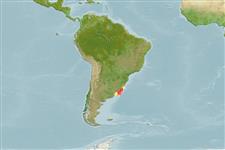Actinopterygii (ray-finned fishes) >
Clupeiformes (Herrings) >
Clupeidae (Herrings, shads, sardines, menhadens) > Alosinae
Etymology: Brevoortia: From James Carson Brevoort (1818-1887), studie the fauna from Ohio and South Caroline (Ref. 45335).
Environment / Climate / Range
Ecology
Marine; brackish; pelagic-neritic; depth range 5 - ? m (Ref. 188). Subtropical, preferred 16°C (Ref. 107945); 30°S - 40°S, 60°W - 48°W (Ref. 188)
Southwest Atlantic: Santos, Brazil to mouth of La Plata, Argentina.
Size / Weight / Age
Maturity: Lm ? range ? - ? cm
Max length : 35.0 cm SL male/unsexed; (Ref. 27363)
Dorsal
spines
(total): 0;
Dorsal
soft rays
(total): 16;
Anal
spines: 0;
Anal
soft rays: 19. Scutes apparent along belly. Upper jaw with distinct median notch. Pectoral fin tip to pelvic fin base or at most short by the width of 3 scales; pelvic fin with oblique and almost straight hind margin. Pre-dorsal scales modified; scales on back and above base of anal fin not markedly smaller than rest (Ref. 188). Back of body greenish blue, sides and belly silvery, fins golden yellow. Large dark spot behind gill cover (Ref. 27363).
Schooling species (Ref. 188). Enters brackish regions of rivers (Ref. 188). Feeds on plankton (Ref. 27363).
Life cycle and mating behavior
Maturity | Reproduction | Spawning | Eggs | Fecundity | Larvae
Whitehead, P.J.P., 1985. FAO Species Catalogue. Vol. 7. Clupeoid fishes of the world (suborder Clupeioidei). An annotated and illustrated catalogue of the herrings, sardines, pilchards, sprats, shads, anchovies and wolf-herrings. FAO Fish. Synop. 125(7/1):1-303. Rome: FAO. (Ref. 188)
IUCN Red List Status (Ref. 115185)
CITES (Ref. 94142)
Not Evaluated
Threat to humans
Harmless
Human uses
Fisheries: minor commercial
More information
ReferencesAquacultureAquaculture profileStrainsGeneticsAllele frequenciesHeritabilityDiseasesProcessingMass conversion
Tools
Special reports
Download XML
Internet sources
Estimates of some properties based on models
Phylogenetic diversity index (Ref.
82805): PD
50 = 0.5156 [Uniqueness, from 0.5 = low to 2.0 = high].
Bayesian length-weight: a=0.00933 (0.00498 - 0.01748), b=3.07 (2.91 - 3.23), in cm Total Length, based on LWR estimates for this species & Genus-body shape (Ref.
93245).
Trophic Level (Ref.
69278): 3.4 ±0.45 se; Based on food items.
Resilience (Ref.
69278): High, minimum population doubling time less than 15 months (Assuming tm=1).
Vulnerability (Ref.
59153): Moderate vulnerability (37 of 100) .
